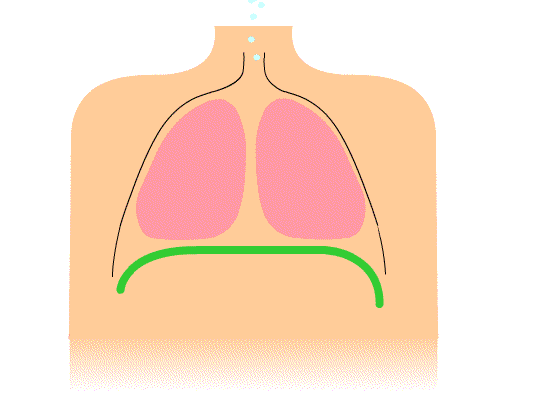 | ||
Diaphragmatic breathing, abdominal breathing, belly breathing or deep breathing is breathing that is done by contracting the diaphragm, a muscle located horizontally between the thoracic cavity and abdominal cavity. Air enters the lungs and the belly expands during this type of breathing.
Contents
- Explanation
- In complementary and alternative medicine
- Relation to yoga and meditation
- Benefits of diaphragmatic breathing
- Relation to singing
- References
This deep breathing is marked by expansion of the abdomen rather than the chest when breathing. It is a form of complementary and alternative treatment.
Diaphragmatic breathing is also known scientifically as eupnea, which is a natural and relaxed form of breathing in all mammals. Eupnea occurs in mammals whenever they are in a state of relaxation, i.e. when there is no clear and present danger in their environment.
Explanation
According to the National Center for Complementary and Integrative Health, "12.7 percent of American adults [have] used deep-breathing exercises... for health purposes," which it describes as follows, "Deep breathing involves slow and deep inhalation through the nose, usually to a count of 10, followed by slow and complete exhalation for a similar count. The process may be repeated 5 to 10 times, several times a day."
According to the University of Texas Counseling and Mental Health Center, "Diaphragmatic breathing allows one to take normal breaths while maximizing the amount of oxygen that goes into the bloodstream. It is a way of interrupting the 'Fight or Flight' response and triggering the body's normal relaxation response." They provide a video demonstration.
In complementary and alternative medicine
Some practitioners of complementary and alternative medicine believe that particular kinds of breathing they identify as diaphragm breathing can be used to bring about health benefits.
Deep breathing exercises are sometimes used as a form of relaxation, that, when practiced regularly, may lead to the relief or prevention of symptoms commonly associated with stress, which may include high blood pressure, headaches, stomach conditions, depression, anxiety, and others.
Due to the lung expansion being lower (inferior) on the body as opposed to higher up (superior), it is referred to as 'deep' and the higher lung expansion of rib cage breathing is referred to as 'shallow'. The actual volume of air taken into the lungs with either means varies.
Relation to yoga and meditation
Hatha Yoga, tai chi and meditation traditions draw a clear distinction between diaphragmatic breathing and abdominal breathing or belly breathing. The more specific technique of diaphragmatic breathing is said to be more beneficial.
Benefits of diaphragmatic breathing
The use of diaphragmatic breathing is commonly practiced, especially in those patients with cardiopulmonary disease, to improve a variety of factors such as pulmonary function, cardiorespiratory fitness, posture, respiratory muscle length, and respiratory muscle strength. Specifically, diaphragmatic breathing exercise is essential to asthmatics since breathing in these patients is of the thoracic type in association with decreased chest expansion and chest deformity as a result of a deformed sternum like pectus excavatum (funnel chest) ; a shortened diaphragm, intercostals and accessory muscles from prolonged spasm causing stenosis of the major airways leading to an abnormal respiratory pattern.
Relation to singing
Diaphragmatic breathing is also widely considered essential for best possible singing performance.
